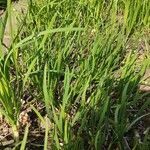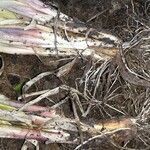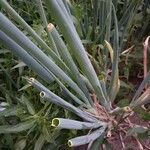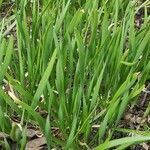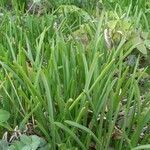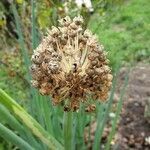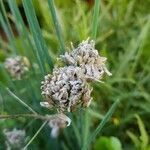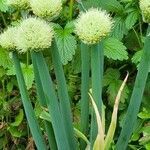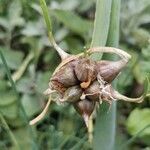Bulb solitary or clustered, cylindric, rarely ovoid-cylindric, 1--2(--4.5) cm in diam.; tunic white, rarely pale red-brown, membranous to thinly leathery, entire. Leaves subequaling scape, 0.5--1.5 cm wide. Scape 30--50(--100) cm, terete, fistulose, covered with leaf sheaths for ca. 1/3 its length. Spathe 2-valved, persistent. Umbel globose, many flowered. Pedicels subequal, slender, 1--3 × as long as perianth, ebracteolate. Perianth white; segments ovate, 6--8.5 × 2.5--3 mm, apex acuminate, with a reflexed point; inner ones slightly longer than outer. Filaments equal, 1.5--2 × as long as perianth segments, connate at base and adnate to perianth segments. Ovary obovoid, with inconspicuous nectaries at base. Style exserted. Fl. and fr. Apr--Aug. 2 n = 16*.
An onion family plant. A bulb plant but the bulb is indistinct. It grows to 60 cm high and 20 cm wide. The roots are side roots and fibrous. They grow in large clumps. The leaves are rounded in cross section and hollow. They grow to 15-30 cm long by 5-20 mm wide. The bulbs are very small and 4-8 cm long but only 5-25 mm across. The plant produces many side buds which develop as offshoots. Flowers grow on a stalk which comes from underground and there are many flowers on stalks around one head. This hollow stalk is 40-80 cm long. The flowers are yellow and they open from the top of the flower head downwards. There can sometimes be bulbils on the flower head.
Bulb indistinct, oblong to ovoid, 3.5-8 cm long, width 5-25 mm, gradually passing into the leaves. Increase bulbs few to several, narrow and inconspicuous. Protective bulbcoat-leaves several, papery, smooth, brownish, whitish, or purplish. Foliage leaves 4-6, erect, terete, fistulose, 20-54 cm by 5-20 mm. Inflorescence (hemi)spherical. Flowers narrowly campanulate to urceolate; tepals pale yellow; stamens longly exceeding tepals.
